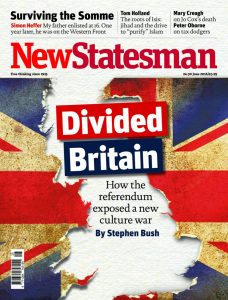How often have you heard it said that a ‘country is deeply divided’?
Tony Blair said it about Britain on Saturday, in his essay ‘Brexit and the Centre’.
Political commentators, amateur or not, said it about France during the presidential primaries and the final election in May.
They say it about the United States.
And about India. The preferred term for the raging argument over secularism vs Hindutva is that India is politically polarised.
That is the only one of the “deeply divided” countries that really is as described.
 “Deep division” is a new phenomenon. It started to occupy pundits beginning some time in 2016. By popular agreement, it is destined to continue well into the future. At least until those “deep divisions” are manifestly overcome, the cracks filled, and a coat of shiny, scrub-able paint applied on top.
“Deep division” is a new phenomenon. It started to occupy pundits beginning some time in 2016. By popular agreement, it is destined to continue well into the future. At least until those “deep divisions” are manifestly overcome, the cracks filled, and a coat of shiny, scrub-able paint applied on top.
But I don’t think so. I don’t believe that everywhere is more deeply divided now. In free societies, different political systems, opinions, parties and beliefs have always co-existed. Sometimes they have angrily fought for the same space. As for inequity – in wealth, entitlements, standard of living, aspiration – well, that’s been around for several thousand years. What’s new? Throughout history, class, age and gender divides have intensified from time to time, in response to events and prevailing opinion.
I’m not sure it’s right to say that having more than one ‘party view’ is sign of a “deeply divided” country. Often it is a conflation of many different things.
Consider Mr Blair’s words about Brexit Britain: “The country is deeply divided: between young and old; metropolitan and outside the cities; better off and worse off.”
Was there ever a time this wasn’t the case?
And here’s the headline of a column on France. It’s written by Margaret Wente in Canada’s largest national daily newspaper, The Globe and Mail: “Don’t exhale just yet. France is still deeply divided”. It was written in April, after the first round of the presidential polls. Emmanuel Macron and Marine Le Pen were through to the finals and Ms Wente basically saw the whole country going to hell in a handcart. In what might have been almost a reprisal of Donald Trump’s inaccurate generalisations, she wrote:“In the run-up to the election, leading foreign journalists who know the country well found no reason to be cheerful. France’s proud old industrial cities have turned to rust. The suburbs of Paris have turned into jihadi factories, and integration has been a failure. France’s inflexible welfare state cannot create jobs for the natives, never mind the newcomers.”
It sounds more like a vision of what Ms Wente wanted to see than France’s reality.
As for the US, it had a fiercely contested presidential election, rather low-level political debate (mostly because Mr Trump is an ignorant brawler) and his victorious campaign assumed a racist, xenophobic and Islamophobic tone. No surprises then in the findings of a post-election November poll: that 85 per cent of Americans think that the US was more divided in 2016, compared to 76 per cent in January 2013.
Politics has divided the US and this looks to continue, adding to the racial and income divides. But “deeply divided” beyond any time before? Those who remember the Vietnam years would probably say not.
Finally, there’s India. Here, there really is a division over a profound change, a basic re-jigging of its very DNA. Stratfor, a US company that supplies intelligence and analysis on events around the world, said the following in March 2016, reflecting the deepening divisions between secularists and Hindu nationalists: “The intensifying clash between the philosophies and the resulting political ramifications will undermine [prime minister] Modi’s already languishing reform agenda, deepen the country’s political polarization and temper economic growth this year.”
That one’s true.

